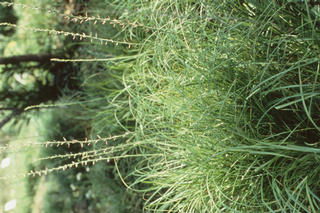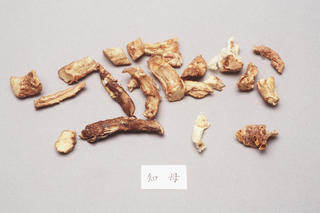Anemarrhena asphodeloides
Contents
Nomenclature
Other Names:
Historical Use of Anemarrhena asphodeloides
Anemarrhena asphodeloides in Traditional Chinese Medicine
Background
Yanzhimu ÑÎ֪ĸ
Chinese Name (pinyin): Zhimu
Chinese Name :
Common Name :Anemarrhena Rhizome
Specific Name : Rhizoma anemarrhenae
Scientific Name:
Collection : The drug is collected in spring and autumn, removed from fibrous root and soil, dried in the sun.
Description : Slat shaped, slightly curved, somewhat compressed, branched occasionally, 3 - 15 cm long, 0.8 - 1.5 cm in diameter. One end exhibiting pale yellowish stem and leaf scars. Externally yellowish brown to brown. The upper surface exhibiting a concave groove and closely arranged annular nodes with dense yellowish brown remains of leaf bases growing upward bilaterally, the lower surface raised and somewhat shrivelled, exhibiting depressions or protruding dotted root scars. Texture hard, easily broken, fracture yellowish white, odour slight, taste slightly sweetish, bitterish and viscous on chewing.
Identification : 1.Shake 2 g of the powder with 10 ml of ethanol, shake on a stand for 20 minutes. Evaporate 1 ml of the supernatant to dryness, to the residue add 1 drop of sulfuric acid, a yellow colour is produced which turns gradually red, violet and brown.2.Heat under reflux 2 g of the powder with 20 ml of ethanol for 40 minutes. To 10 ml of the supernatant add 1 ml of hydrochloric acid, heat under reflux for 1 hour and concentrate to about 5 ml. Add 10 ml of water, extract with 20 ml of benzene and evaporate the benzene extract to dryness. Dissolve the residue in 2 ml of benzene as the test solution. Dissolve sarsasapogenin CRS in benzene to produced a solution containing 5 mg per ml as the reference solution. Carry out the method for thin layer chromatography Appendix Vl B), using silica gel G as the coating substance and benzene acetone (9:1) as the mobile phase. Apply separately to the plate 7 µl of each of the two solutions. After developing and removal of the plate, dry it in the air and spray with a mixture of 8% solution of vanillin in dehydrated ethanol and sulfuric acid solution (1Õ10) (0.5 :5) then heat at 100ºC for 5 minutes. The spot in the chromatogram obtained with the test solution correspond in position and colour to the spot in the chromatogram obtained with the reference solution. Total ash: Not more than 8.5% (Appendix lX K)Assay: To about 1 g of the pulverized sample (pass through No. 3 sieve) and accurately weighed, add accurately 25 ml of ethanol to volumetric flask and weigh, allow to soak overnight and ultrasonicate for 40 minutes, allow to stand, weigh supplement the loss of weight with ethanol. Filter, discard the initial filtrate, measure accurately 10 ml of the successive filtrate, add 1 ml of hydrochloric acid. Heat slowly under reflux on a boiling water bath for 1 hour and cool. To the filtrate in a beaker, add dropwise 40 % solution of sodium hydroxide with shaking to neutralize ( the color of the solution changes from orange-yellow to orange red). Wash the container with ethanol, combine the washings into the beaker. Transfer the solution to50 ml of volumetric flask. Diluter with ethanol to volume, shake well, filter and discard the initial filtrate. Measure accurately 10 ml of the successive filtrate, evaporate to dryness in a dish. Dissolve the residue in a 2 ml of volumetric flask and dilute with benzene to the volume, use as the test solution. Dissolve sarsasapogenin CRS, weigh accurately in benzene to produce a solution containing 0.5 mg per ml as the reference solution. Carry out the method for thin layer chromatography (Appendix Vl B) using silica gel G containing sodium carboxymethyl cellulose as the coating substance and benzene-acetone (9:1) as the mobile phase. Apply 4 µl, 6µl of the reference solution alternately to the plate. After developing to about 7 cm and removal of the plate, dry it in the air and go on the second development with the same mobile phase. Spray with a mixture of 1(to 25ml of water add dropwise slowly 50 ml of sulfuric acid) and 2 (8% solution of vanillin in dehydrated ethanol), keep in refrigerator before use. Heat at 70ºC for 7 - 10 minutes until the color of the spot distinctive. Cover the plate with a piece of glass of the same size, fix the edge with tape. Carry out the method for thin layer chromatography (thin layer chromatographic scanning method) (Appendix Vl B), scan at wavelength of Ûs=443nm, measure the integration value of absorbance, calculate the content. It contains not less than 1% of sarsasapogenin (C27H45O3), calculated on the dried basis.
Processing : Eliminate foreign matter, wash soften thoroughly, cut into thick slices dry and removed hairs and scraps.Processed with salt: Stir fry the slice Rhizoma Anemarrhenae as described under the method for stir frying with salt -water (Appendix ll D) until dry.
Action : To remove heat and quench fire, and to promote the production of body fluid and relieve dryness syndromes.
Indication : febrile diseases with high fever and intense thirst; heat in the lung with dry cough; consumptive fever; diabetes due to internal heat; constipation
Precautions :
Dosage : 6 to 12 g.
Storage : Preserve in a ventilated and dry place, protected from moisture.
Synonymns for Anemarrhena asphodeloides
Patent Medicines and Medicines with Multiple Ingredients that include Anemarrhena asphodeloides
Pharmaceutical Information
Chemical Constituents
Evidence or the Use of Anemarrhena asphodeloides in the Treatment of Epilepesy
Basic Science
Animal Studies
Cohort, Case-Control and Non-Randomized Trials
Randomized Controlled Trials
Meta-Analysis
1st Five Results: pubmed search
Libo Wang, Yumeng Zhao, YuShun Wang, Fengjie Zhang, Yanhui Wei, Nan Li, Yaqin Xu
Preparation, stability, and antibacterial activity of carboxymethylated Anemarrhena asphodeloides polysaccharide-chitosan nanoparticles loaded curcumin.
Int J Biol Macromol: 2024, 264(Pt 2);130787
[PubMed:38548499]
[WorldCat.org]
[DOI]
(I p)
Gelin Xiang, Sa Guo, Nan Xing, Qinyun Du, Jing Qin, Huimin Gao, Yi Zhang, Shaohui Wang
Mangiferin, a Potential Supplement to Improve Metabolic Syndrome: Current Status and Future Opportunities.
Am J Chin Med: 2024, 52(2);355-386
[PubMed:38533569]
[WorldCat.org]
[DOI]
(I p)
Ji-Hyuk Park, Wona Jee, So-Mi Park, Ye-Rin Park, Seok Woo Kim, Hanbit Bae, Won-Suk Chung, Jae-Heung Cho, Hyungsuk Kim, Mi-Yeon Song, Hyeung-Jin Jang
Timosaponin A3 Induces Anti-Obesity and Anti-Diabetic Effects In Vitro and In Vivo.
Int J Mol Sci: 2024, 25(5);
[PubMed:38474161]
[WorldCat.org]
[DOI]
(I e)
Bo-Tao Chang, Yang Wang, Wen-Lian Tu, Zhi-Qing Zhang, Yan-Fang Pu, Li Xie, Fang Yuan, Ying Gao, Ning Xu, Qi Yao
Regulatory effects of mangiferin on LPS-induced inflammatory responses and intestinal flora imbalance during sepsis.
Food Sci Nutr: 2024, 12(3);2068-2080
[PubMed:38455195]
[WorldCat.org]
[DOI]
(P e)
Xi-Ming Dou, Jing-Han Zhang, Xin Wang, Shan-Hu Liu, Yue Shi, Yu-Ying Huang, Xiao-Qin Zhang, Gao-Jie He, Ke-Lu An, Yuan Qi, Xiao-Hui Wang, Sheng-Li Wei, Yuan Zhang
[DNA barcode screening, identification of germplasm resources, and analysis of genetic diversity of Anemarrhena asphodeloides].
Zhongguo Zhong Yao Za Zhi: 2024, 49(1);88-99
[PubMed:38403342]
[WorldCat.org]
[DOI]
(P p)

